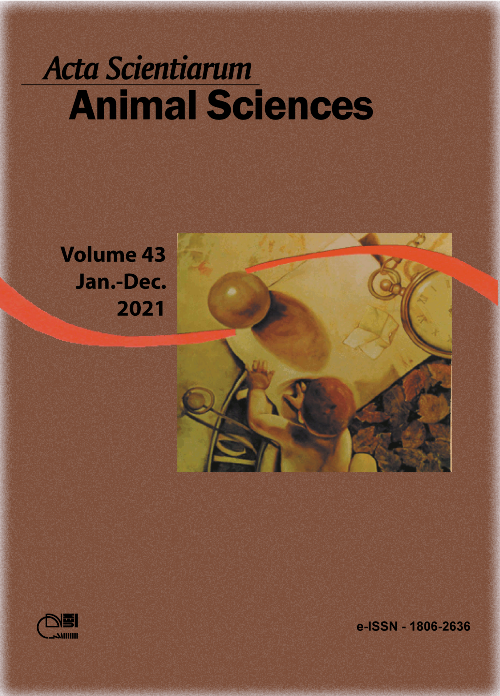Isotopic carbon turnover in pig hoof and rib
Abstract
The objective of this study was to evaluate the behavior of carbon incorporation and turnover in hoof and ribs of pigs at different periods of development in the search for tissues that reflect longer the former diet. We used 132 commercial hybrids (barrows and females), weaned at an average age of 21 days, distributed in a completely randomized design with four treatments on different days of substitution of corn (C4 cycle plant grain) diets with broken rice (C3 cycle plant grain) at 21, 42, 63 and 110 days of age to change the carbon-13 isotope signal. By means of isotopic dilution curves, we observed that animals whose C4 diet was replaced with C3 diet at 21, 42, 63 and 110 days of age, for hoof and rib, reached a new level of isotope equilibrium. Bone samples are better choices to reflect the former diet, due to conservation of the isotopic signal for longer.
Downloads
References
DeNiro, M. J., & Epstein, S. (1978). Influence of diet on the distribution of carbon isotopes in animals. Geochimica et Cosmochimica Acta, 42(5), 495-506. doi: 10.1016/0016-7037(78)90199-0
Ducatti, C., Carrijo, A. S., Pezzato, A. C., & Mancera, P. F. A. (2002). Modelo teórico e experimental da reciclagem do carbono-13 em tecidos de mamíferos e aves. Scientia Agrícola, 59(1), 29-33. doi: 10.1590/S0103-90162002000100003
Fry, B., & Arnold, C. (1982). Rapid 13C/12C Turnover during growth of brown shrimp (Penaeus aztecus). Oecologia, 54(2), 200-204. doi: 10.1007/BF00378393
Gannes, L. Z., Rio, C. M., & Koch, P. (1998). Natural abundance variations in stable isotopes and their potential uses in animal physiological ecology. Comparative Biochemistry and Physiology Part A: Molecular & Integrative Physiology, 119(3), 725-737. doi: 10.1016/S1095-6433(98)01016-2
Grunert, K. G. (2006). Future trends and consumer lifestyles with regard to meat consumption. Meat Science, 74(1), 149-160. doi: 10.1016/j.meatsci.2006.04.016
Hobson, K. A., & Clark, R. G. (1992). Assessing avian diets using stable isotopes I: turnover of 13C in tissues. The Condor, 94, 181-188. doi: 10.2307/1368807
Howland, M. R., Corr, L. T., Young, S. M. M., Jones, V., Jim, S., Van Der Merwe, N. J., … Evershed, R. P. (2003). Expression of the dietary isotope signal in the compound-specific δ13C values of pig bone lipids and amino acids. International Journal of Osteoarchaeology, 13(1-2), 54-65. doi: 10.1002/oa.658
Jenkins, S. G., Partridge, S. T., Stephenson, T. R., Farley, S. D., & Robbins, C. T. (2001). Nitrogen and carbon isotope fractionation between mothers, neonates, and nursing offspring. Oecologia, 129(3), 336-341. doi: 10.1007/s004420100755
Junqueira, L. C., & Carneiro, J. (2004). Histologia básica (10 ed.). Rio de Janeiro, RJ: Guanabara Koogan.
Kennedy, B. V., & Krouse, H. R. (1990). Isotope fractionation by plants and animals: implications for nutrition research. Canadian Journal of Physiology and Pharmacology, 68(7), 960-972. doi: 10.1139/y90-146
Kurle, C. M., & Worthy, G. A. J. (2002). Stable nitrogen and carbon isotope ratios in multiple tissues of the northern fur seal Callorhinus ursinus: Implications for dietary and migratory reconstructions. Marine Ecology Progress Series, 236, 289-300. doi: 10.3354/meps236289
Lopez, A. C., Sobestiansky, J., Coimbra, J. B. S., & Afonso, S. B. (1997). Lesões nos cascos e claudicações em suínos. Concórdia, SC: Embrapa Suínos e Aves.
MacAvoy, S. E., Arneson, L. S., & Bassett, E. (2006). Correlation of metabolism with tissue carbon and nitrogen turnover rate in small mammals. Oecologia, 150(2), 190-201. doi: 10.1007/s00442-006-0522-0
Microcal Software. (1999). Origin data analysis and technical graphics. Microcal Software Inc.
Mirón, L. L. M., Herrera, L. G. M., Ramírez, N. P., & Hobson, K. A. (2006). Effect of diet quality on carbon and nitrogen turnover and isotopic discrimination in blood of a New World nectarivorous bat. Journal of Experimental Biology, 209(Part 3), 541-548. doi: 10.1242/ jeb.02016
Moeller, S. J., Miller, R. K., Edwards, K. K., Zerby, H. N., Logan, K. E., Aldredge, T. L., … Box-Steffensmeier, J. M. (2010). Consumer perceptions of pork eating quality as affected by pork quality attributes and end-point cooked temperature. Meat Science, 84(1), 14-22. doi: 10.1016/j.meatsci.2009.06.023
Nardoto, G. B., Godoy, P. B., Ferraz, E. S. B., Ometto, J. P. H. B., & Martinelli, L. A. (2006). Stable carbon and nitrogen isotopic fractionation between diet and swine tissues. Scientia Agricola, 63(6), 579-582. doi: 10.1590/S0103-90162006000600012
Piasentier, E., Valusso, R., Camin, F., & Versini, G. (2003). Stable isotope ratio analysis for authentication of lamb meat. Meat Science, 64(3), 239-247. doi: 10.1016/S0309-1740(02)00183-3
Rhouma, M., Fairbrother, J. M., Beaudry, F., & Letellier, A. (2017). Post weaning diarrhea in pigs: risk factors and non-colistin-based control strategies. Acta Veterinaria Scandinavica, 59(1), 31. doi: 10.1186/s13028-017-0299-7
Robinson, J. L., Harding, S. V., Brunton, J. A., & Bertolo, R. F. (2016). Dietary methyl donors contribute to whole-body protein turnover and protein synthesis in skeletal muscle and the jejunum in neonatal piglets. The Journal of Nutrition, 146(10), 2007-2012. doi: 10.3945/jn.115.226035
Rostagno, H. S. (2005). Tabelas brasileiras para aves e suínos: composição de alimentos e exigências nutricionais (2 ed.). Viçosa, MG: UFV.
Santos, L. S., Miassi, G. M., Tse, M. L. P., Gomes, L. M., Berto, P. N., Denadai, J. C., … Berto, D. A. (2019). Growth performance and intestinal replacement time of 13C in newly weaned piglets supplemented with nucleotides or glutamic acid. Livestock Science, 227, 160-165. doi: 10.1016/j.livsci.2019.07.008
Tieszen, L. L., Boutton, T. K., Tesdahl, K. G., & Slade, N. A. (1983). Fractionation and turnover of stable carbon isotopes in animal tissues: implications for δ13C analysis of diet. Oecologia, 57(1), 32-37. doi: 10.1007/BF00379558
DECLARATION OF ORIGINALITY AND COPYRIGHTS
- I Declare that current article is original and has not been submitted for publication, in part or in whole, to any other national or international journal.
The copyrights belong exclusively to the authors. Published content is licensed under Creative Commons Attribution 4.0 (CC BY 4.0) guidelines, which allows sharing (copy and distribution of the material in any medium or format) and adaptation (remix, transform, and build upon the material) for any purpose, even commercially, under the terms of attribution.
Read this link for further information on how to use CC BY 4.0 properly.








































